There are plenty of ways to get more eyes on your blog, but time and again, research has shown that organic traffic is the most effective, with the best return on investment. To drive that organic traffic, you have to optimize your website and make your blog SEO friendly for the search engines.
There are a few techniques of search engine optimization you can implement to make your blog SEO friendly, and how to write SEO-friendly blog posts to maximize your traffic, and get your blog noticed.
But let’s see how the process works first.
Table of Contents
How Blogging, SEO, & Google Work
The integration of SEO and blogging which drives traffic through Google is so seamless that is difficult to separate where the role of one ends and the other begins.
*I use Google here to refer to both Google specifically, and also to search engines in general, because Google is still the biggest search engine.
This is an indicative workflow of how they are all connected:
> You optimize your blog posts for Google
> Google finds your blog and ranks you in its SERPs based on hundreds of criteria.
> Users find your blog posts in the SERPs when they search for specific keywords
> They click on your post link and visit your site
> Google notes how the visitor interacts with your blog and adjusts your ranks accordingly
> A high engagement rate indicates to Google that your blog provides value to the visitor and answers their questions.
Google then boosts your site rankings further up, making your blog even more SEO-friendly, and attracting more traffic.
11 Effective Techniques to Make Your Blog SEO-Friendly
Here are a few specific ways you can use SEO methods to optimize your blog posts so that they get into the loop of ranking higher in SERPs and driving attract more traffic.

1. Use Focus and Semantic Keywords Effectively
A key factor of SEO is optimizing your site or blog for keywords related to your niche.
So spend some time selecting relevant keywords for your blog, in a methodical manner.
For each blog post, target one keyword as your focus/ primary keywords, and other related keywords as semantic or LSI keywords throughout the post.
The objective is to give Google lots of clues as to what the content on your website is about. The best keywords would have considerable monthly volumes but low difficulty levels.
Unless you are writing a blog post for affiliate marketing, focus keywords for your blog posts should generally have an informational search intent. I.e. your blog posts should meet the information needs of your audience.
‘How-to’, ‘what’, and ‘how’ keywords, are the best examples (but not the only ones) of informational search intent. Tutorial blog posts are another example of informational content.
If you are writing a blog post to promote an affiliate product, you could also target commercial keywords. For example, ‘best’, ‘review’, ‘affordable’, ‘top’, etc.
Pro Tip for SEO Friendly Blog Posts:
Your focus keyword for one post can be a semantic keyword for a different post.
2. Aim to Rank for Topics, Not Keywords
Even though SEO is a lot about keywords, it is not only that.
It is about being an authority on a subject, which will drive search engines to understand your expertise and rank you high for keywords related to it.
To maximize traffic to your site, create multiple blog posts under the same topic and sub-topics, optimizing each post for keywords in that topic.
For example, if you are trying to optimize your blog for photography tips, you can have multiple categories or topics in your blog with tips about lighting, cameras, filters, etc.
And under each topic, you can have multiple blog posts targeting keywords in that category.
Search engines can then rank your blog as an authority on photography as a whole, driving more traffic to your blog for all topics related to photography.
Pro Tip on How to Write SEO-Friendly Blog Posts:
Pillar pages and hubs are excellent for search engine optimization.
Create these resource pages to organize your content for your audience, provide them the value they need, and optimize your blog for more traffic.
3. Keep Your Blog Updated
SEO gurus have repeatedly stressed the importance of having a blog that’s fresh and regular, for search engines to consider your blog relevant and hence send you traffic.
2 ways to have an updated blog:
- Update old posts
- Create new content
Update old posts
Here’s an example from Ahrefs about how they doubled their traffic by updating an old post.
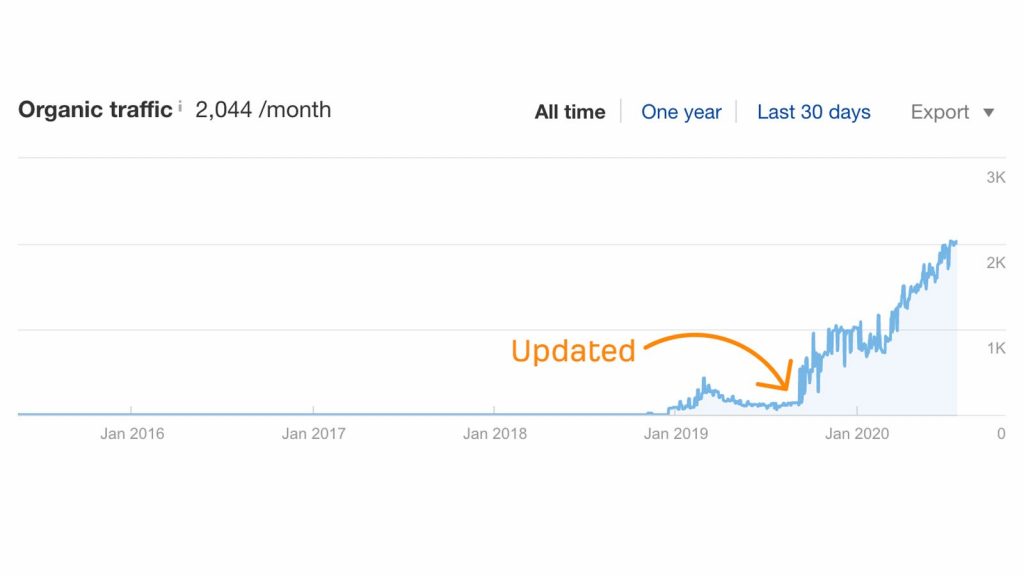
76% of Hubspot’s views come from old blog posts.
Updating old posts is an excellent SEO technique that you can use as a blogger because it means you don’t have to spend time creating a post from scratch.
You just have to refresh it and increase your blog traffic.
Just check your blog for content that you think could be valuable but are being outranked by lower-quality posts from competing sites, and refresh the post.
Some steps to update an old post would be:
- Make it longer with more tips and value-adds
- Use more semantic keywords
- Add more visual media with relevant alt text
- Add the current year to the title of your old posts, along with adding currently relevant content
Create New Content
Refreshing and republishing old blog posts is a great way to improve your SEO and get more traffic.
But it is important to create new content as well. And it’s not just for Google.
Your followers and audience will also know that you constantly provide valuable information which they want to know about, so you will get more repeat traffic to your blog.
Use a content calendar to regularly keep creating new blog posts and updating old posts.
Pro Tip for How to Write SEO Friendly Blog Posts:
If you’re stuck trying to find ideas for new blog posts, conduct a content/ keyword gap analysis in your SEO tool to find the keywords and topics your competitor is ranking high for but you aren’t.
But be careful not to copy their content, or even paraphrase it, as that could be considered plagiarism. Keep your content original, and you can use AI tools to help you create it.
4. Prioritize On-Page Friendly SEO
One essential way to optimize your blog posts for search engines and drive more traffic is to work on your on-page SEO.
On-page SEO refers to optimizing the HTML elements of your post, indicatingo to search engines what it is about, so the engines can index it accordingly, for relevant queries.
Write compelling titles and meta descriptions, structure your content with subheadings, use your focus keyword in your heading tags, add alt text to your images, and keep your URLs short.
Pro Tip for SEO Friendly Posts:
Instead of using your whole headline in your post URL, use only the focus keyword, to keep it short and to the point.
For example, if you have a post ‘25 Best Mother’s Day Gifts She Will Love Forever’, and your focus keyword is ‘mother’s day gifts’, your URL could be as short as: domain.com/mothers-day-gifts.
5. Optimize for Position Zero in Google
When you type in a query on Google, position zero is the result that shows up above the organic search results, with the blue links.
It is usually an answer to a question represented in a paragraph, a list, or a table.
The text in position zero is extracted from a blog post that ranks within the top 10 positions in the SERP, but the blog post itself may be in any position, not necessarily the number one.
It is called a featured snippet when it comes to blog posts. See the example below.
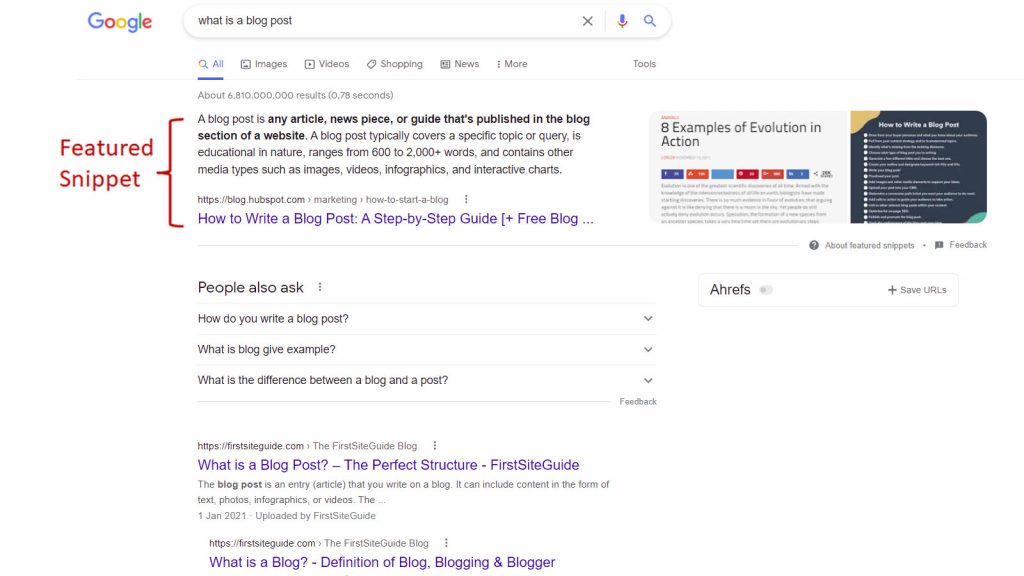
In this case, the blog post from Hubspot answers the question ‘what is a blog post’, and this is shown at the top of the search results page.
Note that this result is on the top (position 0), even though the actual blog post is not within the first 2 results.
That is why it is important to optimize your blog for featured snippets. Even a section of your blog post could make you rank at the top, driving more traffic to your site, even though your full blog post is somewhere below the search results page.
Note: When users are looking for a quick answer to something, they may get the answer from your post in the featured snippets. They may not always click on the post, so you may not get the traffic.
However, repeated appearances of your blog post answers on featured snippets demonstrate your blog expertise. This builds more brand awareness and drives even repeat traffic.
How to optimize your post for featured snippets?
Here are some tips to optimize for featured snippets and position zero:
- Answer questions in your post related to your topic.
- Use long-tail keywords in your blog posts
- Keep answers to questions within 50 words
6. Add Rich Snippets
Rich results or rich snippets are enhanced search engine results that also appear at the top of the search engine result, and also indicate a type of page.
Some common types of posts could be music, a person, a recipe, or even a news article.
All you have to do is specify that to Google.
Below are rich snippets examples of recipes (actually blog posts that are recipes).
They include the image, the title, the ingredients, the cooking time, and the reviews.
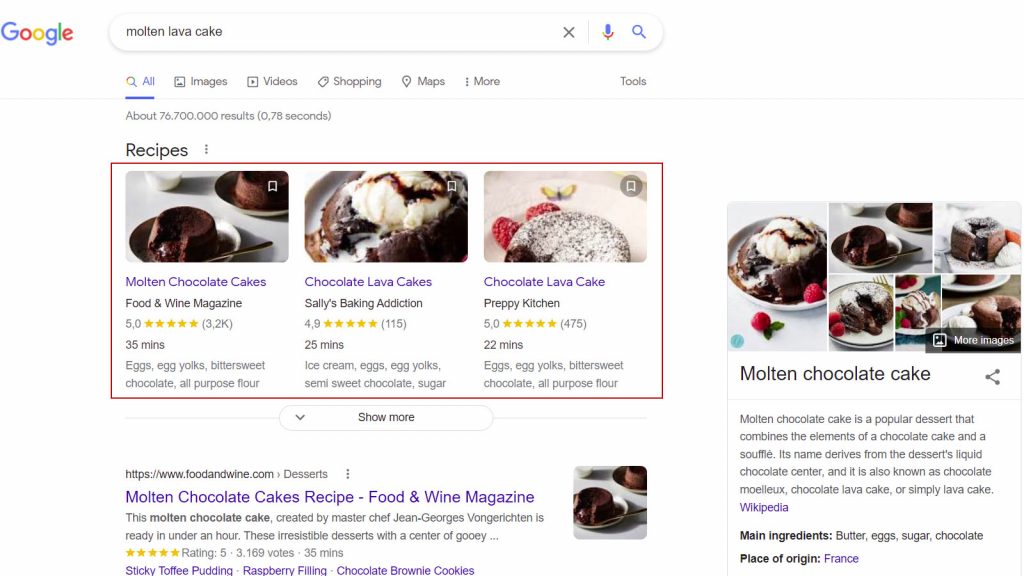
How to optimize your post for rich results?
The best way to feature for rich results is to add structured data or schema markup to your posts.
Schema markup is just a code that structures your content, telling Google the type of your blog post, so it can rank you accordingly for certain searches.
The good news is that you don’t have to know anything about coding or technical stuff to add this code of schema markup.
If you have WordPress, it’s very simple to do that with an SEO plugin like Yoast, RankMath, All-in-one-SEO, etc.
In RankMath for example, once you install and activate the plugin, go to the individual blog post, and click on the RankMath section.
Then click on Schema and choose the appropriate one for your post.
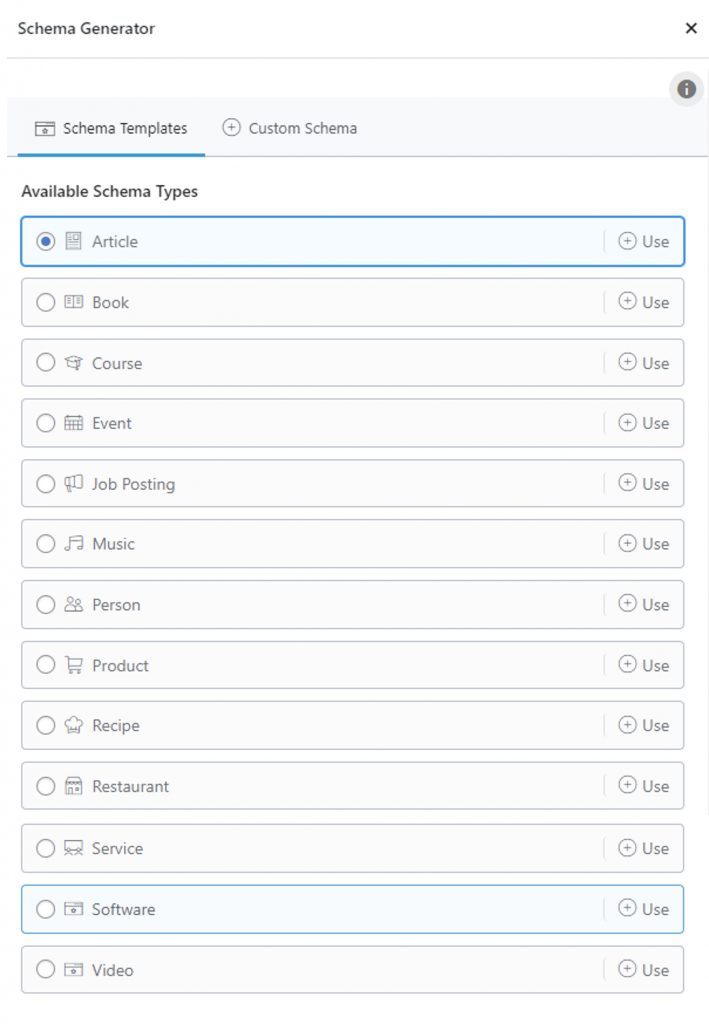
If it is an article you choose, just click on it, and choose the exact nature of your article.
Click on ‘Save for this Post’, and you’re all set!
If you don’t have WordPress, you have to go to Google’s structured data markup helper, add your URL, and make sure all the key elements of the post are mentioned.
Some essential elements of your post would be the title of the post, the website, the brand name, the author, the publication date, etc.
7. Be Smart About Internal Linking For SEO Friendly Posts
Even though internal linking has a big impact on SEO, most marketers and bloggers still don’t use internal linking effectively.
Internal links between different pages/ posts of your site help Google understand the context and content of your blog posts.
It also helps your readers move between different blog posts, engaging more with your content.
That also results in them spending more time on your blog, which signals to Google that your content is valuable, making it rank you higher.
Here are some ways internal linking boosts SEO, driving more traffic to your blog.
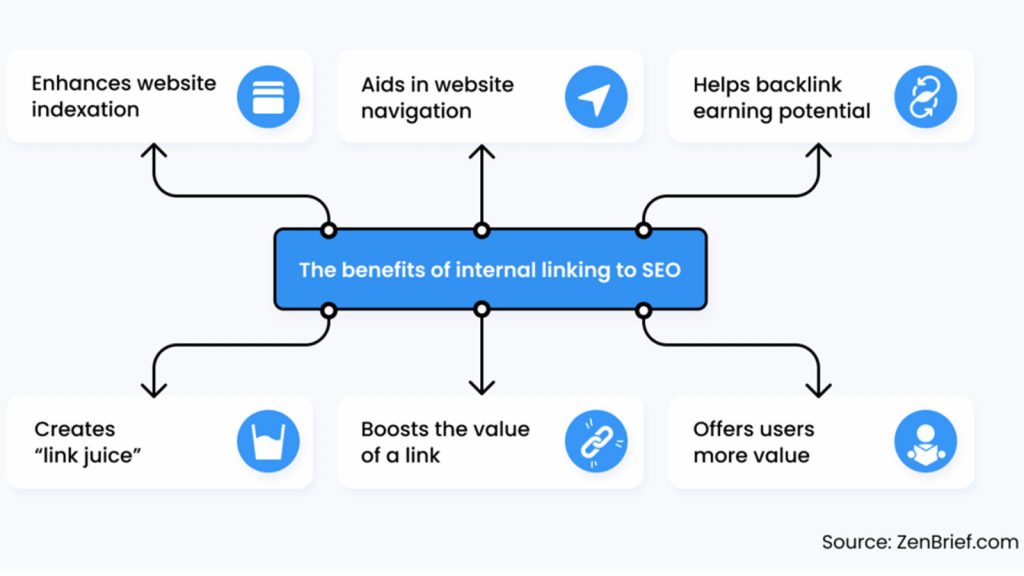
However, it is not advisable to randomly link between blog posts.
Here are some strategic ways to do internal linking:
- Link high-traffic posts to posts you want to rank higher, or to new posts
- Fix orphaned content
- Be sure to link between pillar posts and between pillar posts and cluster posts
Pro Tip for Internal Linking:
If you write blog posts very frequently, which as a blogger you would, then adding internal links to your blog posts could become very tedious and time-consuming.
Link Whisper is a very effective tool to create internal links fast, in a few minutes instead of hours, with just a few clicks, and it’s also very affordable for bloggers and small business owners.
Read the full Link Whisper review to see how it helps you do internal linking very fast, with minimum hassle.
8. Make Your Blog an Easy Browsing Experience
40% of users will abandon a messy website with a low user experience. (Source: Techjury)
You could be writing excellent blog posts with genuine content, but if your visitors find it difficult to browse through your content easily and find answers, then it gives bad signals to Google about the quality of your site and it will drop you in search results.
That means low traffic.
In fact, in 2021 Google introduced a ranking signal called Page Experience, which includes the existing ranking factors plus new ones called Core Web Vitals. It includes elements like the loading performance of a site.

So, implement at least the basics of a good user experience for your blog posts. Some key characteristics are:
- Fast loading speed
- Mobile optimized
- Easy to navigate
- Good design and aesthetics
9. Build Link Partnerships
Links to your website or blog from high-quality websites play a huge role in boosting your SEO.
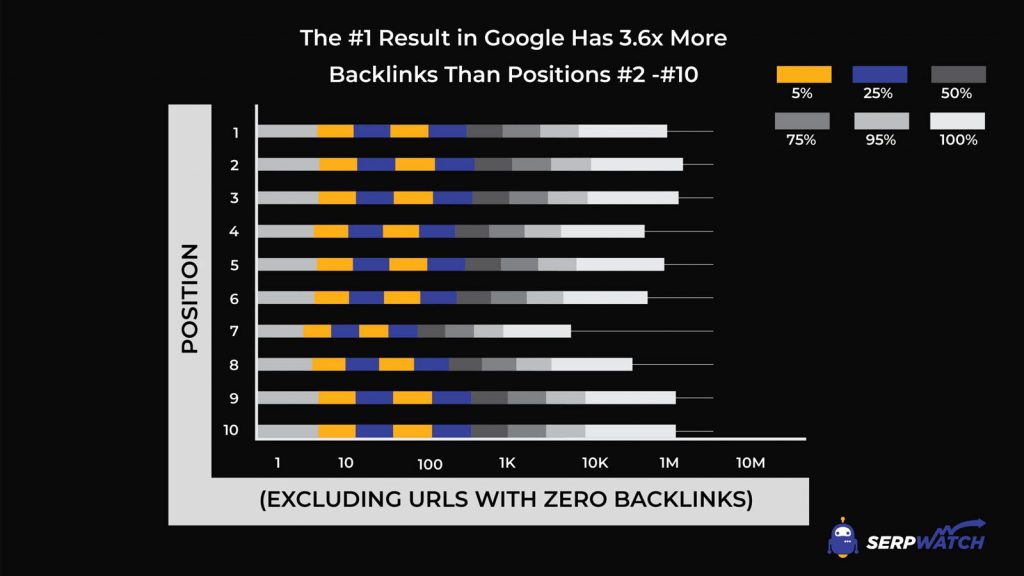
When you work on your SEO and get these backlinks, they improve your blog traffic as well. This is how:
- Because of these links, humans (most likely your target audience) discover your blog posts and check them out.
- The links help Google’s crawlers to follow the trail to your website, improving your blog authority and SEO, and driving more traffic in return.
Link building may be the most difficult aspect of SEO. To build links in the most sustainable, non-begging way, build relationships with industry experts and colleagues.
Share their blogs, link to them, comment on their blogs, talk to them on social media, and thank them for teaching you something.
When you think you have built a relationship and feel comfortable with them, get into collaborations where you can offer them links through your site and others, and they can do the same. Or they can share your post with their email subscribers.
Blogging and link-building are barter worlds, move around in them appropriately.
10. Refine Your Blogging Strategy with Data
If you want to increase your organic reach with your blog, you need to know if your methods are working.
Are you targeting the right keywords? Is your content valuable for your audience? Which post is getting backlinks organically?
Don’t shoot in the dark and waste all your blogging effort and hours.
Track your blog performance, and find keyword and link opportunities with SEO tools. Tweak and fine-tune your blogging and SEO strategy accordingly.
11. Optimize for Voice Search to Become More SEO Friendly
71% of consumers prefer to do a voice search instead of typing. And most of those are on mobile. So one increasingly effective way of driving more blog traffic is by optimizing your post for voice search.
A few simple ways to do that, as outlined in this post by Casey Botticello are:
- Target long-tail keywords. When we speak and search, we are more likely to use full sentences, so make sure your content addresses those queries.
- Answer questions. Your content should include answers to the 5W and H questions: Who, what, when, where, which, and how.
- Keep it conversational: Include idioms and speaking patterns if possible, to keep the tone of your post simple, informational, and easy.
Conclusion of How To Write the Best SEO Friendly Blogs
Those were the key SEO techniques that can make your blog SEO-friendly and improve your blog traffic.
After you write each blog post, don’t forget to promote and distribute it, to drive more traffic to your blog. Check out this complete blogging guide to know all the blogging steps from scratch to finish.
If you are a fresh blogger, know that you need to create quite a few posts to start generating traffic. A magic number could be 15, says expert blogger James McAllister.
Keep working on creating SEO-friendly content, and not only is traffic bound to flow in, but your blog can also become a powerful lead-generator.




Hello, absolutely amazing post. Have got a lot of value from this article. I agree that many leads are generated through the old content, so updating them is always a good idea.
Keep writing such wonderful content.
Romil Rambhad
Thank you, Romil. Definitely, old content can be priceless when it comes to improving your SEO and driving leads.
All great tips Poulomi. Keeping your blog updated is a biggie. I update a few posts daily to add content, remove dead or bad links and to make my content work for me.
Ryan
Hi Ryan. Yes, updating old posts at regular intervals can make a whole lot of difference to your blog traffic. Thanks a lot for commenting!